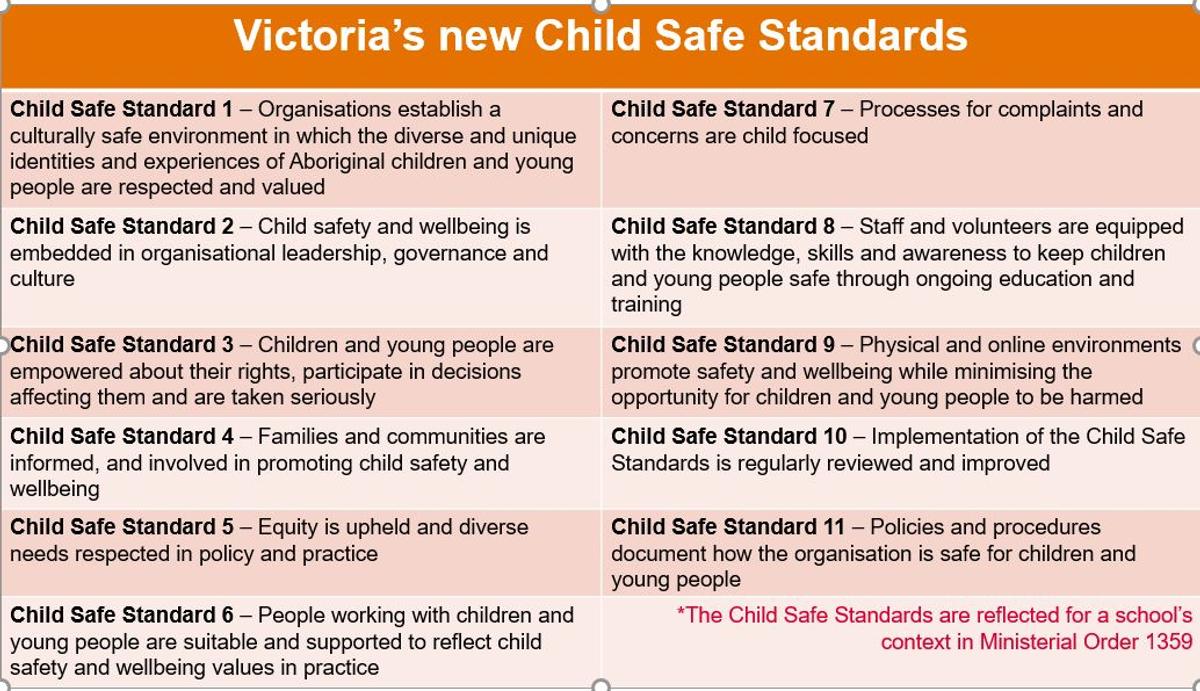CHILD SAFETY IS EVERYONE'S RESPONSIBILITY

CHILD SAFE STANDARD 5
Equity is upheld and diverse needs are respected in policy and practice.
In complying with Child Safe Standard 5
The school council, parents and carers, visitors, staff and principal will:
- develop and endorse a policy statement or curriculum document that details the strategies and actions it will take to uphold diversity and equity, that:
- makes sure school staff and volunteers understand the diverse circumstances of students, and how to provide support, and respond to vulnerable students
- gives students, staff, volunteers and the school community access to information, support and complaints processes in ways that are culturally safe, accessible and easy to understand
- pays particular attention to the needs of:
- students with disability
- students from culturally and linguistically diverse backgrounds
- students who are unable to live at home
- international students
- lesbian, gay, bisexual, trans and gender diverse, intersex and queer (LGBTIQ+) students
- Aboriginal students and provides and promotes a culturally safe environment for them.
Recognise the diverse backgrounds, needs and circumstances of students
- Recognise the range of diverse student and family attributes. Pay attention to:
- cultural safety for Aboriginal and Torres Strait Islander students
- the needs of students with disability and responses to disability
- the needs of students from diverse religious and cultural communities
- the needs of very young students and children
- the impact of prior trauma
- gender differences
- the experiences of lesbian, gay, bisexual, trans and gender diverse, intersex and queer (LGBTIQ+) students
- challenges for students who are in foster care, out of home care, living away from home or international students
- students experiencing pregnancy or who are young parents
- socio-economic factors (experiencing family homelessness, insecure employment or accommodation, individual or family contact with the justice system, poverty, addiction, low educational attainment, remote or regional isolation).
- Pay attention to diverse student cohorts and individuals in your community, recognising that they may have higher risk of harm.
- Normalise asking for and using people’s pronouns and names for students.
- Use contemporary, culturally sensitive and inclusive examples when discussing families, relationships or professions and vocations.
Identify and address challenges that students experience due to their diverse attributes
- Communicate that discrimination and bullying are not tolerated – if incidents of bullying or discrimination occur, address the incident in line with school policy.
- Let students know they can raise concerns or report incidents that occurred at school and outside the school.
- Check in with vulnerable students and their families to confirm their needs are being met. This can occur at pick-up or drop-off, at parent teacher interviews, you tell us or through informal discussions.
- Engage genuinely with students. Find out what matters to them, what they know and don’t know about safety, and what they need to be safe and feel safe.
- Validate students’ feelings. Students may feel that they have not been listened to or believed in the past.
- Offer buddying and mentoring for students who are at risk of social isolation.
- Discuss how students feel about discussing their personal circumstances and respect their wishes. Note that where staff or volunteers have formed a reasonable belief that sharing information is necessary to lessen or prevent a serious threat to an individual’s life, health, safety or welfare, they may be required to share information despite the wishes of the student that their information remain confidential.
- Take a holistic approach when responding to family violence.
- Respond to family violence in a way that is accessible, culturally responsive, safe, child-centred, inclusive and non-discriminatory.
Put in place policies and strategies to help meet the diverse needs of students
- Ensure school environments are welcoming and inclusive. For example:
- display flags representing different cultures within the school community
- provide materials in different languages
- decorate the school with artistic expressions from students and young people.
- Provide child safety information in accessible, child-friendly language and formats.
- Accompany child safety information with the support materials needed to help students and families interpret it.
- Anticipate the needs of students from diverse backgrounds and life circumstances. Don’t expect all students to be equally empowered to ask for what they need.
- Provide staff and volunteers with training to identify and address racism, bullying and discrimination.
- Create opportunities to remind staff and volunteers about student diversity and accommodating students and young people’s needs.
- Seek out expert advice as needed to support inclusion, such as an occupational therapist, speech pathologist, provision planning.
Support diversity through school planning and resources
- Recognise dates that connect with your school community, for example:
- Cultural Diversity Week (March)
- IDAHOBIT (International Day Against Homophobia, Biphobia, Intersexism and Transphobia, 17 May)
- National Reconciliation Week (27 May–3 June)
- World Mental Health Day (10 October)
- International Day of Persons with Disability (3 December)
- Compile a range of age-appropriate instructional materials for exploring differences and similarities in class and across the whole school community including:
- Resilience Rights and Respectful Relationships resources
- Books, and resources that reflect diverse views and perspectives
- Speech and drama scripts that explore themes around diversity.
- Use images of students with diverse characteristics in school publications to reflect the school community.

